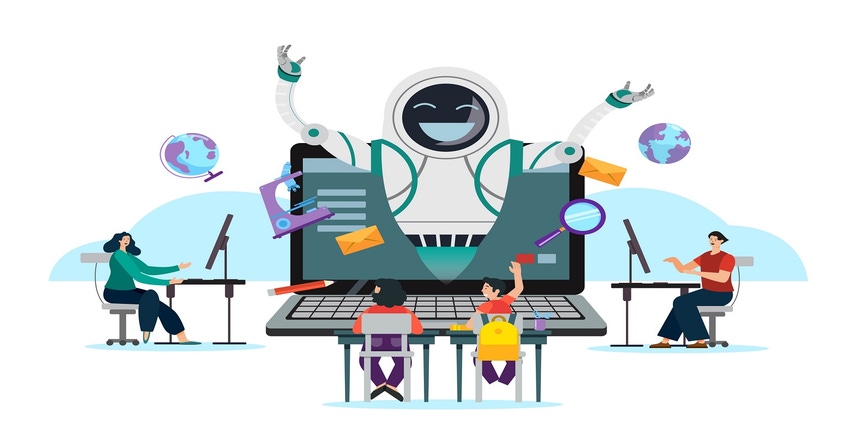Meet Your New Trainer: The Robot
We’ve recently watched AR and VR step into training manufacturing workers. Now, they may be replaced by AI.
September 25, 2023

PwC recently published a 2023 report, Hopes and Fears: How Workers Are Feeling About the Future of Work. The report documents the views of manufacturing workers, showing their hopes and fears as technology and automation expand. The report also quizzed workers about their views on artificial intelligence.
PcW revealed that manufacturing workers are both excited and apprehensive about the digital transformation. Only 28% expressed anxiety about the potential of losing jobs to artificial intelligence. They tend to view AI as an opportunity to upskill and reskill themselves. They want to support AI in the form of training programs and career development opportunities. Training company, Augmentir, notes that manufacturers would be wise to utilize AI to retain workers. This is especially important as skills gaps and labor shortages persist amidst a push to increase US manufacturing operations.
We caught up with Chris Kuntz, VP of strategic operations at Augmentir to get his view on how AI is changing the landscape of training for the manufacturing workforce.
Design News: Explain the ongoing need for training workers in automation and manufacturing.
Chris Kuntz: The connected worker has been around for 8 to 10 years. Since that time, digitalization has affected front-line workers. It has especially blossomed post-pandemic. In manufacturing, it has gone from just a skill gap, and just replacing retiring workers to creating a new workforce with technology skills. Even if every single worker at a durable goods manufacturer were skilled, there would still be a shortage of 20 to 25%. The shortage of skilled workers has the potential to impact US manufacturing by $20 trillion. So, how do you do more with less? Twenty to 30% less staff? It’s not just the shortage of staff; the staff they do have is less skilled and the type of skills required are changing all the time. There are continual increases in Industry 4.0 technology in manufacturing.
DN: Is further automation part of the solution?
Chris Kuntz: You can only automate so many jobs. Some are not going to be automated soon, such as safety workers. Highly repetitive assembly work can be automated. Quality can sometimes be automated, but a lot can’t be automated and AI won’t replace human workers. The solution becomes a matter of attracting workers into your environment.
Recruiters say mfg is not attractive. It’s up to manufacturers to modernize their floors. Many are using the same equipment they used 20 years ago and they’re using paper-based manuals. Modernizing that process will make it more attractive. Upskilling and reskilling need to happen. New levels of programming need to happen. This means jobs in programming and robot configuring jobs. There are new jobs and opportunities, and manufacturers need to do a better job modernizing the plant to attract employees.
DN: How about sustainability? Workers are interested in working with corporate employers that have sustainability goals.
Chris Kuntz: I agree, you can take the displaced worker and make that worker skilled. One of the hidden uses of AI – retraining – is helping, it is suited to teaching skilled jobs. You can also use AI to identify the workers who are most likely to do the upskilling. This is an opportunity if you understand your workforce. AI can shine a light on where you put your people. AI can also help with upskilling and reskilling.
DN: What’s the role of AR and VR in a world that moving toward AI training?
Chris Kuntz: I think AR and VR have a place. But traditional training will be replaced with training that is closer to the work. We think there will be more training in the flow of work. When you have five moments to learn. You need to learn as things change or when they go wrong. That happens all the time in factories. It is difficult to apply AR and VR in those places. Instead, the solution could be a collaboration session or an AI bot. Imagine if you had an AI bot that could sit alongside you and say, “Hey, here’s how to do this, or offer a routine to get you through the next five steps.” That can be in the flow of work.
DN: How does Augmentir fit into the world of training the connected worker?
Chris Kuntz: Augmentir is a software company. We build software products in manufacturing. We use AI to augment the worker. Use AI to analyze workers so organizations can improve training support. The goal is to help manufacturers do more with less. This is becoming more accessible to mid and small manufacturers. We’re talking to companies using tech from 20 years ago. They have modernized their equipment, but not their processes. They’re still using paper, for quality, maintenance, and safety. There’s an element of human error. If you can digitize that, you can streamline a lot of what you do.
About the Author(s)
You May Also Like





